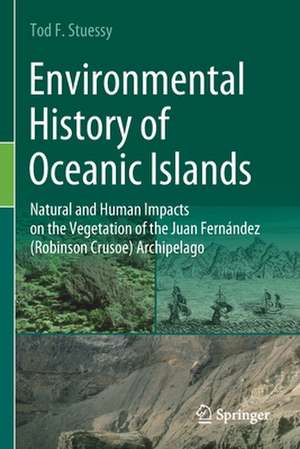Environmental History of Oceanic Islands: Natural and Human Impacts on the Vegetation of the Juan Fernández (Robinson Crusoe) Archipelago
Autor Tod F. Stuessyen Limba Engleză Paperback – 2 iul 2021
| Toate formatele și edițiile | Preț | Express |
|---|---|---|
| Paperback (1) | 947.67 lei 6-8 săpt. | |
| Springer International Publishing – 2 iul 2021 | 947.67 lei 6-8 săpt. | |
| Hardback (1) | 953.82 lei 6-8 săpt. | |
| Springer International Publishing – 2 iul 2020 | 953.82 lei 6-8 săpt. |
Preț: 947.67 lei
Preț vechi: 1155.69 lei
-18% Nou
Puncte Express: 1422
Preț estimativ în valută:
181.39€ • 197.10$ • 152.47£
181.39€ • 197.10$ • 152.47£
Carte tipărită la comandă
Livrare economică 21 aprilie-05 mai
Preluare comenzi: 021 569.72.76
Specificații
ISBN-13: 9783030478735
ISBN-10: 3030478734
Ilustrații: XX, 341 p. 106 illus., 39 illus. in color.
Dimensiuni: 155 x 235 mm
Greutate: 0.51 kg
Ediția:1st ed. 2020
Editura: Springer International Publishing
Colecția Springer
Locul publicării:Cham, Switzerland
ISBN-10: 3030478734
Ilustrații: XX, 341 p. 106 illus., 39 illus. in color.
Dimensiuni: 155 x 235 mm
Greutate: 0.51 kg
Ediția:1st ed. 2020
Editura: Springer International Publishing
Colecția Springer
Locul publicării:Cham, Switzerland
Cuprins
Chapter 1. Introduction.- Part I. The Archipelago.- Chapter 2. The importance of the islands.- Part II. Modern flora and vegetation.- Chapter 3. Native and endemic flora.- Chapter 4. Introduced species.- Chapter 5. Vegetational patterns.- PART III. Three historial documentation of human activities.- Chapter 6. Discovery and early exploration (1574-1749).- Chapter 7. Colonial period (1750-1819).- Chapter 8. Early botanical period (1820-1875).- Chapter 9. Floristic period (1876-1906).- Chapter 10. Skottsberg (1907-1917).- Chapter 11. Touristic period (1918-1959).- Chapter 12. Modern period (1960-present).- Part IV. Summaries of impacts on vegetation.- Chapter 13. Natural factors.- Chapter 14. Human influences.- Part V. Conservation.- Chapter 15. Existing conservation efforts.- Chapter 16. Recommendations for the future.- Index.
Notă biografică
Professor Stuessy’s research involves many aspects of the systematics, evolution, and biogeography of flowering plants. Different types of studies include monography, phylogenetic and biogeographic analysis, and population genetics. Much interest has been placed on understanding population genetic differentiation and speciation in various genera of Compositae, especially Hypochaeris (tribe Lactuceae) and Melampodium (tribe Heliantheae). Emphasis has been on using molecular markers from the chloroplast and nucleus for phylogenetic analysis as well as phylogeographic studies with AFLPs and microsatellites at the populational level. Principal questions have dealt with understanding modes of speciation, especially involving chromosomal change, and the testing of biogeographic hypotheses. The geographic focus for these studies has been in southern South America and Mexico. Another major emphasis of researchhas been on island biology, particularly the evolution of the endemic species of the Robinson Crusoe (Juan Fernandez) Islands off the coast of Chile, which is also a Chilean national park. These investigations have been completed in collaboration with Chilean colleagues from the Universidad de Concepcion and have spanned three decades. Of particular recent interest has been understanding the genetic consequences of anagenetic (transformational) versus cladogenetic speciation. A final area of research has dealt with concepts and methods of biological classification. Different approaches for quantitative evolutionary classification have been proposed as a means of incorporating more phylogenetic information into formal classification to amplify predictive value.
Textul de pe ultima copertă
The Juan Fernández Archipelago is located in the Pacific Ocean west of Chile at 33° S latitude. Robinson Crusoe Island is 667 km from the continent and approximately four million years old; Alejandro Selkirk Island is an additional 181 km west and only one million years old. The natural impacts of subsidence and erosion have shaped the landscapes of these islands, resulting in progressive changes to their subtropical vegetation. The older island has undergone more substantial changes, due to both natural causes and human impacts. After the discovery of Robinson Crusoe Island in 1574, people began cutting down forests for lumber to construct boats and homes, for firewood, and to make room for pastures. Domesticated plants and animals were introduced, some of which have since become feral or invasive, causing damage to the local vegetation. The wealth of historical records on these activities provides a detailed chronicle of how human beings use their environment for survival in a new ecosystem. This book offers an excellent case study on the impacts that people can have on the resources of an oceanic island.
Caracteristici
Offers a unique view on the archipelago where Alexander Selkirk spent four years in isolation Reveals how landscape modification occurs through a combination of natural and human impacts Includes color maps, charts, and drawings highlighting significant voyages to the southeastern Pacific archipelago
